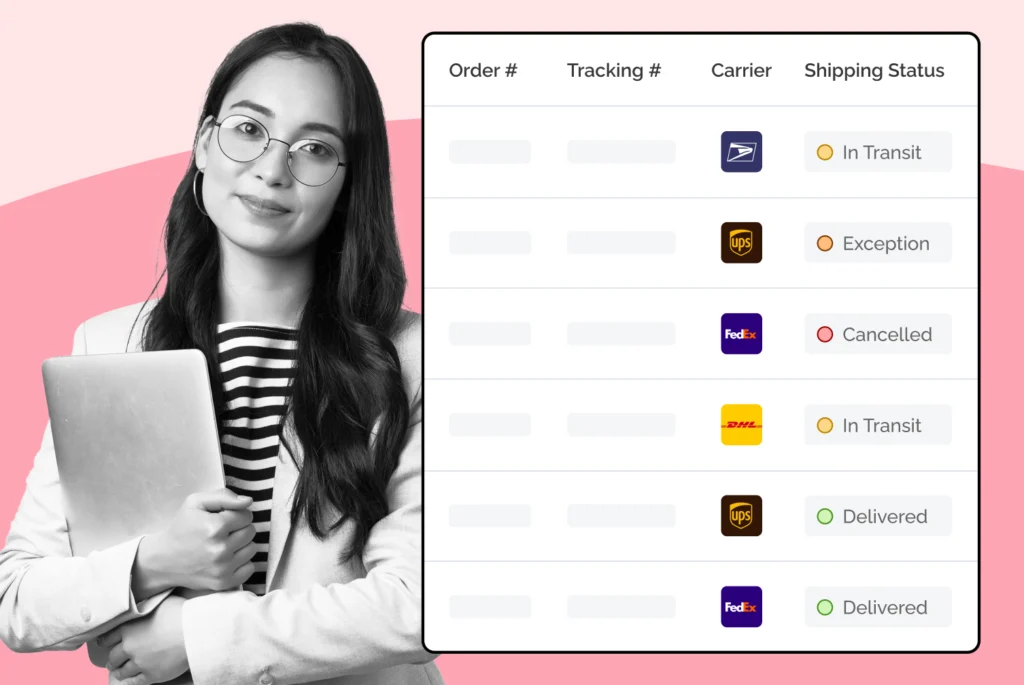
5 Proven Ways to Turn BFCM Returns into Revenue in 2025
Discover effective strategies to turn BFCM returns into profitable opportunities. Boost your revenue this season.
Shipping, Tracking & Notifications
Boost customer experience and reduce support tickets
Realtime order and shipment tracking
Proactive order and shipping notifications
AI-Enhanced Discounted Labels
Predictive pre-purchase estimated delivery dates
Self-Serivce branded order tracking
Effortless experience delivered
Identify and Resolve Order Issues
Realtime order and shipment tracking
Make returns profitable and delight customers
Flexibility to define any return destinations & conditions
Simplify returns for your customers and team
Incentivize exchanges over returns
Returns management made easy for your team
Returns management made easy for your team
Easy claims and smart upsells
Understand why your customers are returning
In-Store & Curbside Pickup
Unify the online and the in-store experience
Hassle-free pickup experience for customers
In-Store dashboard to keep operations streamlined
In-Store and Online orders unified
Drive foot-traffic to your stores
Shipping, Tracking & Notifications
Boost customer experience and reduce support tickets
Realtime order and shipment tracking
Proactive order and shipping notifications
AI-Enhanced Discounted Labels
Predictive pre-purchase estimated delivery dates
Self-Serivce branded order tracking
Effortless experience delivered
Identify and Resolve Order Issues
Realtime order and shipment tracking
Make returns profitable and delight customers
Flexibility to define any return destinations & conditions
Simplify returns for your customers and team
Incentivize exchanges over returns
Returns management made easy for your team
Returns management made easy for your team
Understand why your customers are returning
In-Store & Curbside Pickup
Unify the online and the in-store experience
Hassle-free pickup experience for customers
In-Store Dashboard to keep operations streamlined
In-Store and Online orders unified
Drive foot-traffic to your stores
Boost customer experience and reduce support tickets
Realtime order and shipment tracking
Proactive order and shipping notifications
AI-Enhanced Discounted Labels
Predictive pre-purchase estimated delivery dates
Self-Serivce branded order tracking
Effortless experience delivered
Make returns profitable and delight customers
Flexibility to define any return destinations & conditions
Simplify returns for your customers and team
Incentivize exchanges over returns
Returns management made easy for your team
Equip your team for precise return checks.
Easy claims and smart upsells
Understand why your customers are returning
Unify the online and the in-store experience
Hassle-free pickup experience for customers
In-Store Dashboard to keep operations streamlined
In-Store and Online orders unified
Drive foot-traffic to your stores
Find the answer to all your questions
Take a step by step trip through our functionality to see how we can improve your ecommerce processes.
Explore the most comon questions about WeSupply
Calculate the ROI that WeSupply can bring you
Read actionable articles on how to optimize your post-purchase experience and decrease support tickets
Get inspired by stories of how our customers implemented an effortless post-purchase experience
Wondering if WeSupply is a good fit for you? Read through our use cases to see how we can help you increase conversion & improve CX!
A Deep Dive into Top Companies' Order Tracking & Returns Strategy
Find the answer to all your questions
Explore the most comon questions about WeSupply
Calculate the ROI that WeSupply can bring you
Request a no strings attached review of your current shopping experience and missed conversion opportunities
Take a step by step trip through our functionality to see how we can improve your ecommerce processes.
Read actionable articles on how to optimize your post-purchase experience and decrease support tickets
Get inspired by stories of how our customers implemented an effortless post-purchase experience
A Deep Dive into Top Companies' Order Tracking & Returns Strategy
Wondering if WeSupply is a good fit for you? Read through our use cases to see how we can help you increase conversion & improve CX!

If you’ve ever ordered something online, you’ve probably noticed that the cost of shipping can make or break the deal. For businesses, especially online shops, shipping costs are more than just a line on a receipt. They directly affect profit, customer satisfaction, and competitiveness. Applicable discounts can significantly reduce shipping costs and should be factored into calculations. A package that costs too much to send might scare customers away. On the other hand, underestimating costs can eat into profits quickly. Shipping discounts can also help businesses offer more attractive shipping rates to customers, improving their competitiveness.
That’s why knowing how to calculate shipping costs is so important. Whether you are a small business owner shipping a handful of packages each week, a company managing hundreds of deliveries, or simply someone mailing a gift across the country, understanding the rules that carriers use to set their prices is essential.
In the United States and worldwide, the main players are USPS, UPS, FedEx, and DHL. Each one has its own pricing structure and tools, but the basic principles are similar. Let’s break down those principles first and then explore how each carrier calculates shipping.
Shipping costs aren’t pulled out of thin air. They depend on a combination of package details, destination, and service choices. Let’s look at the key factors that all carriers consider.
Weight vs. Dimensional Weight: The first thing carriers look at is how heavy the package is. A heavier box costs more because it takes more fuel and effort to move. But carriers don’t stop at the scale. They also consider how much space a package occupies. Shipping rates are often calculated based on either the actual weight or the space the package occupies. This is called dimensional weight, or sometimes volumetric weight. It’s calculated by multiplying length × width × height and dividing by a number called a divisor. For UPS, FedEx, and DHL, the divisor is usually 139. USPS uses 166 for domestic shipments. To determine the correct dimensions for shipping calculations, it’s essential to measure the longest side of the box accurately. If the dimensional weight is higher than the actual weight, you pay for the larger number.
For example, imagine mailing a giant box of pillows. It might only weigh 10 pounds, but because it takes up so much space, the carrier might charge as if it weighs 40 pounds. This system keeps pricing fair and prevents trucks from filling up with large but light packages that don’t bring in enough revenue.
Distance and Zones: Carriers divide the country into zones based on ZIP codes. The farther the package travels, the higher the zone, and usually the higher the cost. A shipment from New York to Boston may fall into Zone 2 or 3, while New York to Los Angeles could be Zone 8 or 9.
Service Speed: The faster you want your package delivered, the more you’ll pay. Overnight or next-day services can cost several times more than ground shipping. For example, UPS Next Day Air often costs more than $60 for a medium package, while UPS Ground for the same shipment might be under $20.
Extras and Surcharges: Carriers also add costs for extras like insurance, delivery confirmation, or requiring a signature. Residential delivery often comes with a small surcharge because it’s less efficient than delivering to a business address. Fuel surcharges, which rise and fall with oil prices, also appear frequently on bills. Hazardous materials may incur additional fees due to special handling requirements.
International Costs: When shipping across borders, customs duties, taxes, and clearance fees come into play. According to the U.S. International Trade Commission, average import duty rates globally range from 5–20% of the item’s value, depending on the product and country. This means that even if shipping looks affordable, duties can double the total cost.
Each carrier offers a range of options. For domestic shipments, you’ll usually pick between economy, ground, and expedited services. Economy is cheapest but slowest, while expedited options like overnight are fastest but cost the most. Different services are designed to deliver packages within specific timeframes, allowing you to choose the best balance between speed and cost.
International shipping adds more complexity. Carriers offer choices like air freight for speed or ocean freight for large, heavy shipments at a lower cost. Courier services like DHL specialize in quick, door-to-door international delivery, often arriving in just two to three days. Choosing the right service depends on your package’s weight, size, destination, and how quickly it needs to arrive. Proper packaging is essential to ensure your shipment is delivered safely and cost-effectively, as it helps prevent damage and can impact shipping rates.
Estimating shipping costs is a vital part of the shipping process, whether you’re sending a single package or managing regular shipments. To get an accurate quote, start by gathering your shipment details: package weight, dimensions, and the destination country or zip code. These factors are the foundation for calculating how much you’ll pay.
Most carriers and third-party platforms offer a shipping calculator that makes this process simple. You simply enter the package’s weight, dimensions, and destination zip code, and the calculator will instantly show you a full list of shipping options and their prices. This allows you to compare services side by side and estimate shipping costs before you commit.
For domestic shipments, the process is straightforward just input your details and review the available shipping services. For international shipping, estimating costs can be more complex. You’ll need to consider additional factors like customs duties, taxes, and possible surcharges, which vary by destination country. Some calculators will include these in the estimate, while others may only show the base shipping price.
By taking the time to estimate shipping costs using accurate shipment details, you can avoid surprises and choose the shipping option that best fits your needs and budget. Whether you’re looking for the cheapest way to ship or the fastest delivery, a shipping calculator is your best tool for making informed decisions.
The United States Postal Service (USPS) is often the most affordable option for small or lightweight packages, especially within the U.S.
To calculate costs, you can use the USPS Price Calculator online. You’ll need to enter the package’s weight in pounds and ounces, its dimensions, and the origin and destination ZIP codes. You’ll then see options like First-Class Mail for lightweight items under 13 ounces, Priority Mail for packages up to 70 pounds, and USPS Ground Advantage for slower, less expensive delivery.
USPS also offers Flat Rate Boxes and Envelopes. With these, if it fits, it ships weight doesn’t matter (as long as it’s under 70 pounds). A small flat-rate box currently costs about $10.40, which is often cheaper than paying by weight for heavier items.
Another special option is Cubic Pricing, available to businesses that ship frequently. This program uses the size of the package rather than its weight, and it can save a lot of money for small, dense packages.
If you need to ship internationally, USPS provides several options for sending packages across borders. For international shipments, USPS calculates costs based on weight, size, and country groups. For example, sending a 2-pound package from New York to London might cost around $38–$45 with USPS Priority Mail International. When you ship internationally, be sure to provide a complete description of the parcel contents on customs forms to avoid delays and ensure accurate processing. Also, consider additional factors such as duties, taxes, and customs fees when estimating total shipping costs.
United Parcel Service (UPS) is a strong choice for heavier packages and for businesses that need reliable ground or air services.
To calculate costs, you can use the UPS Calculate Time and Cost tool online. Enter the package dimensions, weight, and both origin and destination ZIP codes. UPS will show you service options like UPS Ground, UPS 2nd Day Air, and UPS Next Day Air.
UPS uses dimensional weight with a divisor of 139. That means a box measuring 20 × 20 × 20 inches would have a dimensional weight of about 58 pounds, even if the actual weight is just 25 pounds. UPS charges whichever is greater.
It’s also important to note that UPS pricing differs depending on how you ship. If you drop off a package at a UPS Store, you’ll usually pay Retail Rates, which can be higher. Businesses with accounts often qualify for Daily Rates, which can be significantly cheaper. By creating a UPS account, businesses can access lower rates and a wider range of shipping options.
For example, shipping a 5-pound package from Chicago to Miami with UPS Ground might cost around $16–$22 online, but the same package could cost over $25 if you pay retail rates at a store.
With UPS’s online tools, it’s easy to start shipping right away.
FedEx is well known for its fast services, particularly overnight and express options.
To get a shipping quote, you can use the FedEx Rate Finder. The shipping quote provided may reflect applicable discounts if you sign in with your FedEx account. This helps users compare options and choose the best service. Like UPS, FedEx bases costs on the greater of actual weight or dimensional weight, also using the 139 divisor.
FedEx offers a wide range of services:
FedEx Ground, which usually delivers in 1–5 business days.
FedEx Express Saver, which promises delivery in three days.
FedEx 2Day and FedEx Standard Overnight for faster service.
FedEx also applies surcharges for packages that are hard to handle, such as non-stackable boxes or items that don’t fit standard shapes. According to FedEx’s 2025 service guide, these surcharges can add $15–$30 per package.
For example, shipping a 3-pound box from Seattle to Dallas via FedEx Ground may cost around $14–$18, while the same package with FedEx Standard Overnight could jump to $70 or more.
DHL is the go-to choice for international shipments. While it does offer some domestic options in select regions, it is best known for global delivery.
To calculate costs, DHL provides a Get a Quote tool, which offers a free shipping quote. You’ll need to enter the package’s dimensions, weight, origin, destination country, and a complete description of what’s inside. DHL then gives you an estimated cost, including potential surcharges and customs-related fees.
DHL specializes in fast international service. For example, sending a 2-pound package from New York to London might cost around $55–$70, but it will usually arrive in 2–3 days, often faster than USPS or other carriers.
DHL also includes features like customs clearance and duties calculation in its quotes, helping businesses avoid surprises. For international shipments, providing a complete and accurate description of the package contents is essential for smooth customs clearance and to prevent delays.
Shipping rates are calculated based on factors like package weight, dimensions, destination, and delivery speed. Each carrier has its strengths, and their shipping rates are calculated based on different criteria:
USPS is usually cheapest for small, light domestic packages, with shipping rates often calculated based on weight and distance.
UPS shines for heavier domestic shipments and reliable ground delivery, with rates calculated based on both weight and package dimensions.
FedEx is strong for express and overnight needs, and its shipping rates are calculated based on service type, speed, and package details.
DHL dominates international shipping with its global network, and its shipping rates are calculated based on international zones, weight, and delivery speed.
Let’s take a quick example. Imagine you’re shipping a 5-pound package measuring 12 × 8 × 6 inches from Chicago to Los Angeles with a 2–3 day delivery window:
USPS Priority Mail: about $12–$15
UPS 2nd Day Air: about $35–$45
FedEx 2Day: about $38–$50
DHL Express: about $40–$60 (if available domestically)
This shows why comparing shipping rates is so important. The cheapest choice can save you 20–70% depending on the carrier and service.
Compare Carrier Costs to Cut Shipping spend
Book a quick call with our experts to see how WeSupply helps you save 20–70% by comparing USPS, UPS, FedEx, and DHL rates in real time.
Finding the cheapest way to ship your package is all about smart comparison and optimization. With so many shipping options available from carriers like UPS, USPS, and DHL, it pays to shop around. Start by using a shipping calculator to compare prices for different shipping services just enter your package size, weight, and destination to see a range of options and their costs.
To save even more, look for discounted rates offered by carriers or through third-party shipping platforms. Many services provide affordable shipping solutions, especially if you’re flexible with delivery speed or can adjust your package size and weight. Sometimes, simply choosing a slightly slower shipping service or using a smaller box can make a big difference in shipping costs.
Don’t forget to factor in extras like insurance, tracking, and delivery guarantees. While the cheapest way to ship is important, you also want to ensure your package arrives safely and on time. By carefully comparing shipping options, considering all relevant factors, and taking advantage of available discounts, you can find the most affordable way to ship your package helping you stay within budget while delivering great service to your customers or recipients.
Carriers know that shipping is competitive, so they offer discounts and promotions. UPS and FedEx often provide lower rates to businesses that ship in bulk or sign contracts. USPS offers special commercial pricing for high-volume shippers. DHL gives discounts for account holders shipping internationally.
Third-party platforms can unlock savings even for individuals. For example, Easyship reports that users save an average of 30–50% compared to retail carrier rates. These services automatically apply applicable discounts to your shipping rates, ensuring you get the best possible deal.
International shipping is more complex than domestic. In addition to weight and size, you must consider customs duties, taxes, and regulations. Each country has its own rules, and failure to provide proper paperwork can delay delivery or result in fines. When declaring the value of used items for customs, sellers can check average selling prices on eBay to help determine an accurate value.
Carriers like DHL and FedEx simplify this by including customs clearance in their services. USPS international services are often cheaper but may take longer and leave customs handling to the recipient.
To keep costs under control:
Always measure and weigh packages accurately.
Optimize packaging by selecting the right materials and sizes to reduce shipping costs and prevent damage.
Use flat-rate boxes for heavy but small items.
Choose ground shipping when time is not critical.
Take advantage of volume discounts or online booking.
Regularly compare rates across carriers to avoid overpaying.
Many people accidentally pay more than they should because of common mistakes. Entering incorrect weights or dimensions can lead to unexpected surcharges. Choosing overnight delivery when ground would have been fast enough wastes money. Forgetting about customs duties on international shipments can create headaches for recipients. To avoid delays and fines, always provide complete information on customs forms.
Avoiding these mistakes is simple: double-check package details, use shipping calculators, and always consider whether the chosen service truly matches your needs.
Figuring out shipping costs can feel confusing. Each carrier USPS, UPS, FedEx, and DHL has different prices, rules, and delivery speeds. That means businesses spend extra time comparing rates, switching between websites, and trying not to make mistakes. WeSupply helps make this process simple, faster, and more affordable.
Here’s how WeSupply takes away the stress and helps you calculate shipping costs the smart way:
See All Rates in One Place
Compare USPS, UPS, FedEx, and DHL instantly no more opening ten different tabs.
Get Discounted Shipping Costs
Save up to 83% on shipping with built-in discounts, no contracts or minimums required.
Pick the Best Carrier for Every Order
Choose the cheapest, fastest, or most reliable carrier for each shipment with just a click.
Automatic Order Sync
WeSupply connects directly to your store and fills in shipping info for you, so there’s no copy-paste or guesswork.
Insurance & Tracking Built-In
Protect packages, keep customers updated with branded tracking, and reduce “Where’s my order?” calls.
International Shipping Made Simple
Ship anywhere in the world with one platform no need to juggle multiple carrier accounts.
Instead of spending hours figuring out how to calculate shipping costs across USPS, UPS, FedEx, and DHL, WeSupply does the heavy lifting. That means lower costs, fewer mistakes, and happier customers all in just a few clicks. Schedule Your Demo Now
Calculating shipping costs across USPS, UPS, FedEx, and DHL doesn’t have to be overwhelming. Each carrier offers different rates, rules, and delivery speeds, but with WeSupply you can compare them all in one place no guesswork, no wasted time.
Our platform connects directly to your store, auto-fills shipping details, and gives you instant access to discounted rates of up to 83% with no contracts or volume minimums. You can switch carriers on the fly, ship internationally, add insurance, and keep customers updated with branded tracking and notifications. By turning a complicated process into just a few clicks, WeSupply helps you ship faster, smarter, and more affordably while improving the customer experience.
With WeSupply, calculating shipping costs becomes not just easier it becomes a growth opportunity for your business.
Returns Analytics for eCommerce Business
Book a quick call with our experts to see how WeSupply can help you understand why your customers are returning: Identify the most returned products, Understand why those products are returned, Identify which customers are serial returners, Reduce Return Rate with Actionable Insights, Returns data available in BigQuery.
1. How do I calculate shipping costs for USPS, UPS, FedEx, and DHL?
Use each carrier’s online calculator. Enter package weight, dimensions, origin, and destination. Compare rates, factoring in dimensional weight, zones, delivery speed, and surcharges.
2. What is dimensional weight in shipping?
Dimensional weight measures package volume relative to actual weight. Carriers charge the greater of the two. UPS, FedEx, and DHL use divisor 139; USPS uses 166 for domestic shipments.
3. Why is accurate shipping cost calculation important?
Accurate shipping costs protect profits, prevent customer drop-offs, and ensure competitiveness. Overestimating can hurt sales; underestimating reduces margins. Factoring discounts and surcharges avoids surprise fees.
4. How does WeSupply help compare shipping rates?
WeSupply instantly shows USPS, UPS, FedEx, and DHL rates side by side, so businesses can quickly pick the cheapest, fastest, or most reliable shipping option.
5. Can WeSupply reduce shipping costs?
Yes. WeSupply offers built-in discounts of up to 83% on shipping rates with no contracts or volume commitments required.
6. Does WeSupply integrate with online stores?
Absolutely. WeSupply syncs orders automatically, fills in shipping details, and eliminates manual entry, saving businesses time and reducing errors.
7. Does WeSupply have an Official Shopify App?
Yes. WeSupply has an Official Shopify App. You can download it and start integrating with your Shopify Store.
8. Does WeSupply have an official Magento extension?
Yes, WeSupply has an official extension for Magento. The WeSupply x Magento integration allows for automating order tracking experiences, reducing customer inquiries, automating shipping email and SMS notifications, and providing a fully branded order tracking experience
9. Does WeSupply have an official BigCommerce App?
Yes, WeSupply has an official BigCommerce App. You can integrate WeSupply with your BigCommerce store to improve your post-purchase customer experience.
Learn How To Create Successful Post Purchase Email Campaigns
Build an effective post-purchase email flow that helps you increase customer satisfaction and drive revenue growth!
Negotiate better terms with suppliers. Partnering with reliable suppliers and carriers creates leverage in negotiations. For example, committing to steady shipping volume can lead to lower rates or priority service by securing discounts based on quantities shipped.

Discover effective strategies to turn BFCM returns into profitable opportunities. Boost your revenue this season.

Discover effective BFCM shipping strategies to enhance your sales this holiday season. Maximize efficiency and delight your customers.

Discover essential strategies to streamline bulk returns handling and enhance efficiency. Read the article for practical tips!

Master post-holiday returns management with effective strategies that streamline processes and enhance customer satisfaction.

Master the art of managing BFCM returns and exchanges with effective strategies that boost eCommerce success.

Discover effective BFCM shipping strategies to enhance your sales this holiday season. Maximize efficiency and delight your customers.

Discover essential strategies to streamline bulk returns handling and enhance efficiency. Read the article for practical tips!

Master post-holiday returns management with effective strategies that streamline processes and enhance customer satisfaction.

Streamline your returns management with our guide to mastering the enterprise RMA process. Enhance efficiency and reduce hassle.